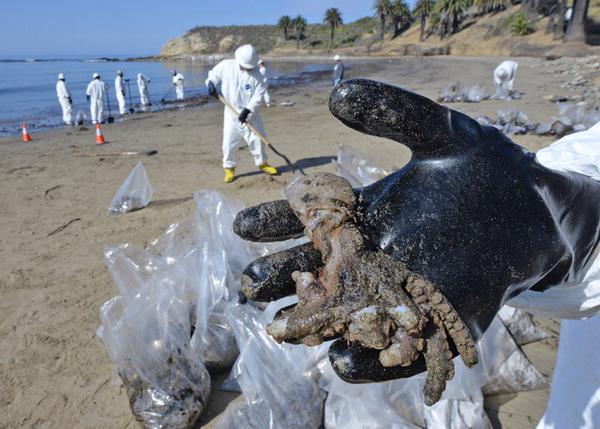As a former graduate student at UC Santa Barbara, I remember vividly my time spent at Refugio State Beach on so many gorgeous sunny afternoons. The scene was almost too beautiful to believe, with glittering green water, chalky white cliffs dotted with palm trees, and so many dolphins that you were almost guaranteed to catch a glimpse of one every time.
Which makes it all the more painful to see the pictures of this spectacular beach now marred by more than 100,000 gallons of crude oil, polluting more than nine miles of the Santa Barbara coast. This spill is such a stark reminder of the fact that  even the most pristine, cherished places are not safe from the very real impacts of our continued dependence on fossil fuels—and a demonstration that it truly is a matter of when, not if, this infrastructure will spill and tarnish our land and water.
even the most pristine, cherished places are not safe from the very real impacts of our continued dependence on fossil fuels—and a demonstration that it truly is a matter of when, not if, this infrastructure will spill and tarnish our land and water.
We've seen the heartbreaking photos of beachgoers trying to rescue oil soaked birds from the blackened beaches, aerial photos of migrating whales appearing to swim directly through the slick, and oiled sea lions lying on the beach. And this pipeline was only pumping 1,300 to 2,000 barrels per hour—a mere fraction of the 800,000 barrels per day that the proposed Keystone XL tar sands pipeline would pump through the critical Ogalalla aquifer in the fragile Sandhills region of Nebraska. Although California Governor Jerry Brown has declared an official state of emergency in response to the spill, officials indicate the cleanup effort could take months.
So how we can continue to deepen our reliance on oil, allowing pipelines to slice across our heartland and oil rigs to punch holes into the Arctic seafloor, when we see these devastating consequences again and again? We know that the few safety regulations that do exist to govern the oil industry’s dirty deeds are barely enforced and are hardly sufficient to truly protect our land and water—let alone our climate.
We know that that these companies cannot and should not be entrusted to protect our natural resources on their own (the company responsible for the Santa Barbara spill seems to be a particularly negligent actor, with a rate of safety violations more than three times the national average). We also know that if we hope to avoid increasingly disastrous effects of climate change, like the record-breaking, debilitating drought California is currently suffering, we need to wean ourselves off of fossil fuels sooner rather than later.
And yet, we also know that the solutions to this problem are out there—we simply need the political will to make them happen. As Governor Brown has emphasized with his visionary commitment to cut California’s oil use 50 percent by 2030, we can decrease the oil we use as a society by investing in public transportation, community planning, and efficient vehicles. We don’t need ever-increasing oil resources, brought to us by increasingly extreme and dangerous oil infrastructure, like oil rigs in the Arctic ocean, exploding bomb trains (which soon may be coming to the Santa Barbara coast if we don’t stop them), or massive tar sands pipelines. What we need is a firm commitment to clean energy solutions and regulations that will keep our communities and climate safe while we bring those solutions to scale.
It’s devastating to see what’s happening in Santa Barbara, and my thoughts are with the community, workers, and wildlife harmed by the spill. Let’s not let this happen yet again. It’s time to stand together and demand that our elected officials invest in the clean energy solutions and regulatory protections that can truly safeguard our communities and our climate.
TAKE ACTION: Stop the proposed Alberta Clipper tar sands oil pipeline!
Top photo: A dead, oiled octopus washed up on Refugio State Beach. Photo courtesy of Mike Eliason. Second photo is of the oil spill's pathway from pipeline to Refugio State Beach. Photo courtesy of the U.S. Coast Guard.
